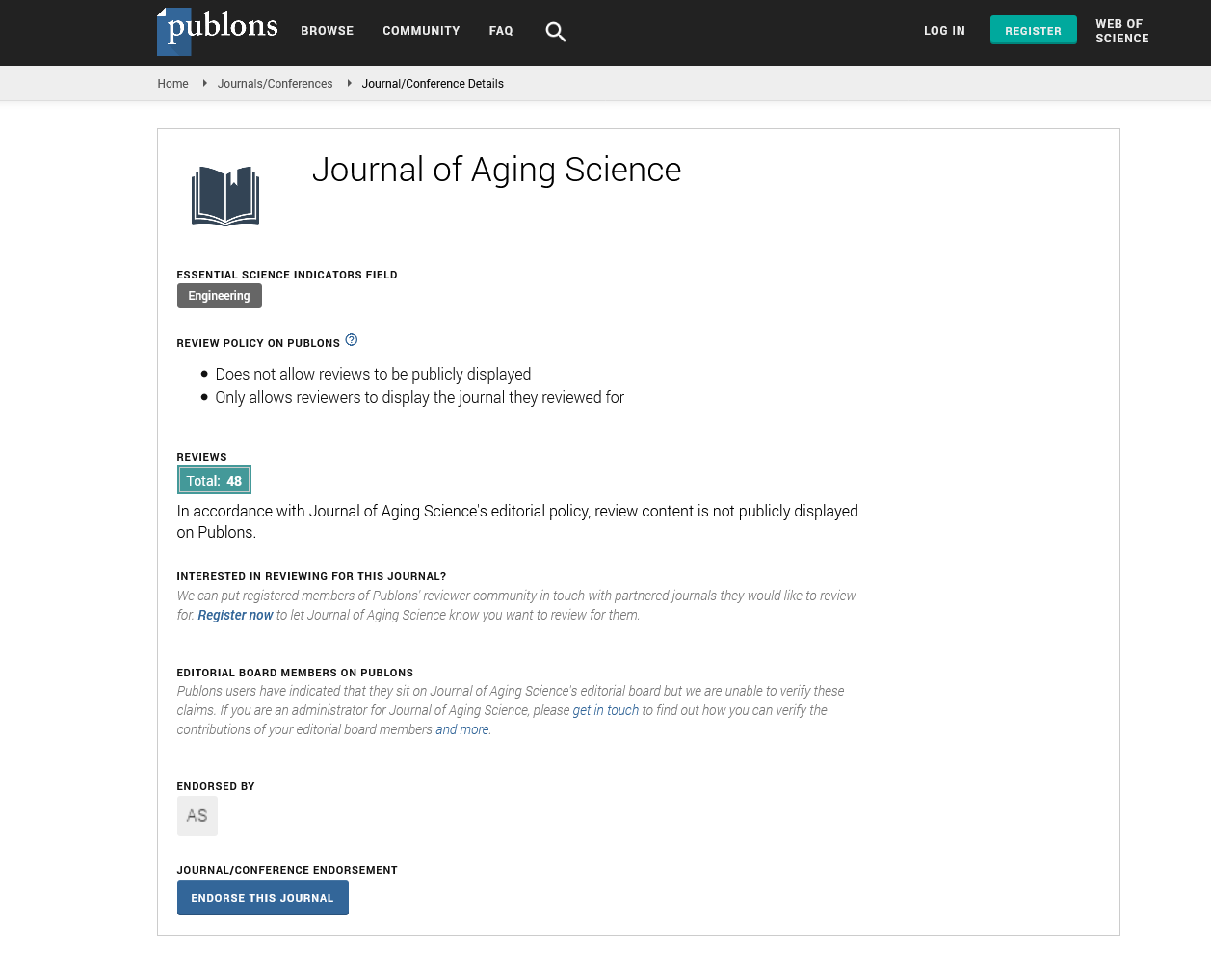Indexed In
- Open J Gate
- Academic Keys
- JournalTOCs
- ResearchBible
- RefSeek
- Hamdard University
- EBSCO A-Z
- OCLC- WorldCat
- Publons
- Geneva Foundation for Medical Education and Research
- Euro Pub
- Google Scholar
Useful Links
Share This Page
Journal Flyer

Open Access Journals
- Agri and Aquaculture
- Biochemistry
- Bioinformatics & Systems Biology
- Business & Management
- Chemistry
- Clinical Sciences
- Engineering
- Food & Nutrition
- General Science
- Genetics & Molecular Biology
- Immunology & Microbiology
- Medical Sciences
- Neuroscience & Psychology
- Nursing & Health Care
- Pharmaceutical Sciences
Commentary - (2024) Volume 12, Issue 4
Emerging Therapies Targeting Mitochondrial Dysfunction in Age-Associated Disorders
Jane Mullens*Received: 27-Nov-2024, Manuscript No. JASC-24-27782; Editor assigned: 29-Nov-2024, Pre QC No. JASC-24-27782 (PQ); Reviewed: 13-Dec-2024, QC No. JASC-24-27782; Revised: 20-Dec-2024, Manuscript No. JASC-24-27782 (R); Published: 26-Dec-2024, DOI: 10.35248/2329-8847.24.12.391
Description
Mitochondria, often referred to as the powerhouses of the cell, plays an important role in maintaining cellular energy balance and metabolic health. However, as organisms age, mitochondrial function declines due to accumulated damage, impaired biogenesis and reduced efficiency in clearing dysfunctional organelles. This mitochondrial dysfunction is a characteristic of aging and is implicated in various age-associated disorders, including neurodegenerative diseases, cardiovascular conditions and metabolic syndromes. Emerging therapeutic strategies aim to mitigate mitochondrial dysfunction, offering new hope for managing these conditions and promoting healthy aging. This essay explores the mechanisms of mitochondrial dysfunction in aging and highlights potential therapies that target this fundamental process.
Mitochondrial dysfunction and aging
Mitochondria, often referred to as the "powerhouses of the cell," plays an important role in energy production through oxidative phosphorylation. As individuals age, mitochondrial function tends to decline, leading to reduced efficiency in energy production and increased production of Reactive Oxygen Species (ROS). These ROS can cause oxidative damage to mitochondrial DNA (mtDNA), proteins and lipids, increasing the dysfunction in a vicious cycle.
Oxidative stress: Mitochondria are major producers of Reactive Oxygen Species (ROS) during energy production. Excessive ROS generation, coupled with declining antioxidant defenses, leads to oxidative stress, causing damage to mitochondrial DNA (mtDNA), proteins and lipids.
mtDNA mutations: Accumulation of mutations in mtDNA impairs the synthesis of necessity proteins required for Oxidative Phosphorylation (OXPHOS), reducing mitochondrial efficiency and contributing to cellular dysfunction.
Impaired mitochondrial biogenesis
With age, the activity of transcription factors and coactivators such as Peroxisome Proliferator-Activated Receptor-Gamma Coactivator 1-Alpha (PGC-1α) declines, reducing the production of new mitochondria.
Defective mitophagy: Mitophagy, the selective degradation of damaged mitochondria via autophagy, is less efficient in aging cells. The accumulation of dysfunctional mitochondria increases cellular stress and promotes inflammation.
These factors collectively contribute to the pathogenesis of age- associated disorders, making mitochondria a critical therapeutic target.
Therapies targeting mitochondrial dysfunction
Emerging therapies to combat mitochondrial dysfunction aim to restore mitochondrial health through various approaches, including enhancing biogenesis, improving quality control and reducing oxidative stress. Below are some of the most potential strategies:
Activation of PGC-1α: PGC-1α is a master regulator of mitochondrial biogenesis. Activating this pathway can enhance the production of new mitochondria and improve cellular energy metabolism.
Resveratrol: A natural compound found in red wine, resveratrol activates PGC-1α via the SIRT1 pathway, enhancing mitochondrial function. Studies show that resveratrol supplementation improves metabolic and cardiovascular health in aging models.
Exercise mimetics: Compounds like AICAR and GW1516 represent the effects of exercise by activating AMPK and PGC-1α pathways, promoting mitochondrial biogenesis and improving endurance.
Mitophagy activators: Restoring the efficiency of mitophagy helps clear damaged mitochondria, reducing cellular stress.
Urolithin A: A metabolite derived from polyphenols found in pomegranates, urolithin A stimulates mitophagy, improving mitochondrial function and muscle health in preclinical studies.
NAD+ precursors: NAD+ is a coenzyme critical for mitochondrial function. Declining NAD+ levels with age impair mitophagy and cellular metabolism. Supplementation with NAD+ precursors like Nicotinamide Riboside (NR) or Nicotinamide Mononucleotide (NMN) restores NAD+ levels, enhancing mitophagy and delaying age-related decline.
Antioxidants: Targeted antioxidants can neutralize ROS, preventing oxidative damage to mitochondria.
MitoQ: A mitochondria-targeted antioxidant, MitoQ is designed to accumulate within mitochondria and directly reduce oxidative stress. Clinical trials suggest benefits in reducing vascular dysfunction in aging.
SkQ1: Another targeted antioxidant, SkQ1, has shown potential in preclinical studies for protecting mitochondrial membranes from oxidative damage and improving healthspan.
Modulating mitochondrial dynamics
Mitochondrial health depends on an effective balance between fusion and fission processes, which maintain mitochondrial integrity and function.
Fusion enhancers: Fusion allows damaged mitochondria to combine with healthier ones, diluting defects and restoring functionality.
Experimental compounds targeting mitochondrial fusion proteins like Mitofusin-1 (MFN1) and MFN2 are being developed to promote mitochondrial repair and improve cellular health.
Fission modulators: Excessive mitochondrial fission is associated with aging and neurodegenerative diseases. Strategies to inhibit excessive fission proteins, such as DRP1, are under investigation for conditions like Alzheimer’s disease.
Mitochondrial replacement therapy: Mitochondrial Replacement Therapy (MRT) is an innovative approach aimed at replacing damaged mitochondria with healthy ones.
Mitochondrial transplantation: Preclinical studies demonstrate that transplanting healthy mitochondria into damaged cells improves energy metabolism and cellular survival, particularly in ischemic conditions.
Gene therapy approaches: Gene therapy holds significant potential for addressing mitochondrial dysfunction at its genetic roots.
CRISPR/Cas9: Advances in gene-editing technologies like CRISPR/Cas9 have enabled targeted correction of mtDNA mutations, offering potential cures for mitochondrial disorders.
TFAM overexpression: Increasing the expression of mitochondrial Transcription Factor A (TFAM), a key regulator of mtDNA maintenance, improves mitochondrial function and reduces aging-associated defects in preclinical models.
Elamipretide: A peptide-based drug, elamipretide improves mitochondrial membrane potential and enhances ATP production. Clinical trials have shown its potential in treating mitochondrial myopathies and cardiovascular conditions.
Metformin: Widely used for diabetes, metformin activates AMPK and improves mitochondrial efficiency, showing potential as an anti-aging therapeutic.
Implications for age-associated disorders
Targeting mitochondrial dysfunction has far-reaching implications for various age-related diseases:
Neurodegenerative diseases: Therapies enhancing mitochondrial health hold potential for Alzheimer's, Parkinson's and Huntington's diseases by reducing oxidative stress and improving neuronal energy supply.
Cardiovascular diseases: Improving mitochondrial function in endothelial and cardiac cells can mitigate risks of hypertension, atherosclerosis and heart failure.
Metabolic disorders: Enhancing mitochondrial biogenesis and mitophagy can address insulin resistance, obesity and type 2 diabetes.
Conclusion
Mitochondrial dysfunction is a central driver of aging and age- related disorders. Emerging therapies targeting mitochondrial biogenesis, quality control, oxidative stress and effectives represent a potential frontier in medicine. With advancements in pharmacological, genetic and lifestyle interventions, the potential to restore mitochondrial health and delay aging-related decline is becoming increasingly tangible. Continued research and clinical trials will be necessity for translating these discoveries into effective treatments, offering new hope for extending healthspan and improving quality of life in aging populations.
Citation: Mullens J (2024). Emerging Therapies Targeting Mitochondrial Dysfunction in Age-Associated Disorders. J Aging Sci. 12:391.
Copyright: © 2024 Mullens J. This is an open-access article distributed under the terms of the Creative Commons Attribution License, which permits unrestricted use, distribution and reproduction in any medium, provided the original author and source are credited.

